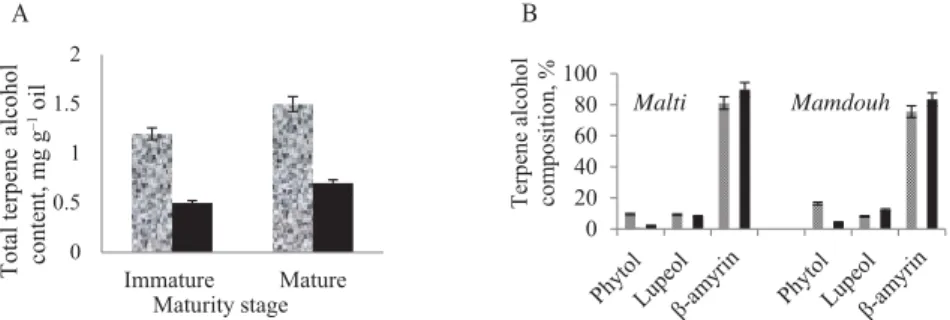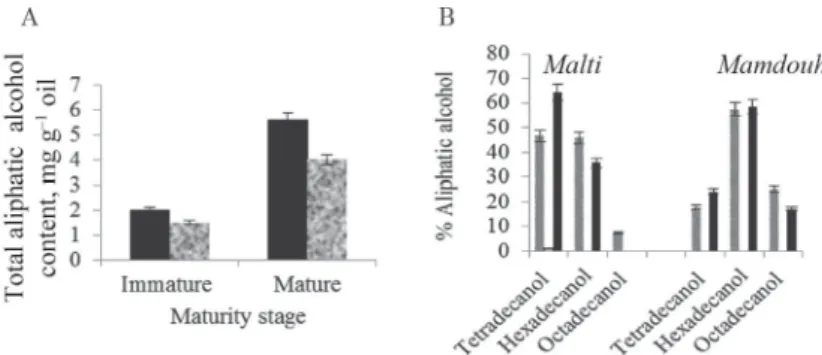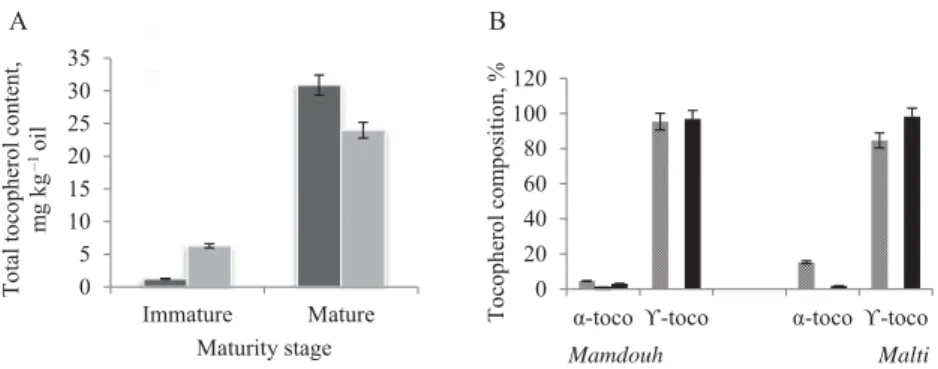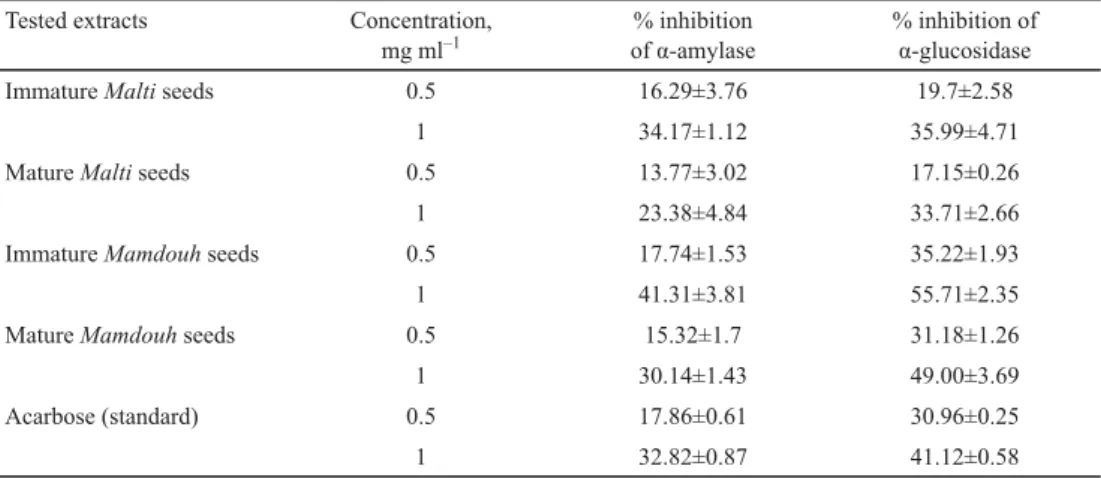DOI: 10.1556/066.2020.49.3.3
BIOACTIVE LIPIDS, ANTIBACTERIAL, HYPOGLYCAEMIC, AND ANTIOXIDANT POTENTIALS OF IMMATURE AND MATURE VICIA FABA L. SEEDS CULTIVATED IN TUNISIA
A. F a,b*, S. H b, M. F b and H. F b
aFaculty of Science, University of Tunis El Manar, 1007, Tunis. Tunisia
bLaboratory of Clinical Biochemistry, LR99ES11, Faculty of Medicine, University of Tunis El Manar, 1007, Tunis. Tunisia
(Received: 22 November 2019; accepted: 19 March 2020)
Both the immature and mature Vicia faba L. seeds are used for human consumption. However, there is a lack of information on the phytochemical composition and the potent biological properties of the immature seeds. The aim of the present study was to establish the profi le of bioactive lipids as well as the antibacterial, antioxidant, and α-amylase and α-glucosidase inhibitory capacities of the immature and mature Vicia faba L. seeds. The studied petroleum ether extracts contain diff erent bioactive compounds such as β-sitosterol, lupeol, β-amyrin, α-tocopherol, and γ-tocopherol. The extracts of the immature seeds exhibited higher antioxidant and antibacterial activities than those of mature ones. All tested extracts exerted higher inhibition on α-glucosidase than α-amylase. The immature seeds appeared as promising sources of natural antioxidants, antibacterial compounds, and α-amylase and α-glucosidase inhibitors. Thus, the immature Vicia faba L. seeds have a great potential as functional foods providing health benefi cial properties.
Keywords: Vicia faba L., immature seeds, bioactive lipids, antibacterial activity, natural antioxidants, enzyme inhibitors
Human pancreatic α-amylase and α-glycosidase catalyses the hydrolysis of starch to glucose and their activity in the small intestine leads to hyperglycaemia. Thus, the inhibition of α-amylase and α-glycosidase has been adopted as a therapeutic strategy for the treatment of type-2 diabetes (L et al., 2018). The synthetic inhibitors of these enzymes are not site- specific and have various side eff ects compared to natural inhibitors (L et al., 2018).
Antioxidant compounds provide health benefi ts by preventing oxidative stress related diseases. Recently, there is a growing demand for natural antioxidants due to both consumers’
preference and side eff ects linked with the use of synthetic antioxidants. On the other hand, the emergence of bacterial resistance to existing antibiotics has led to search of new antibacterial substances, especially from natural sources (B et al., 2018). Therefore, there is a high interest in the evaluation of the antibacterial and antioxidant capacities of diff erent plant extracts, which were thought to be natural sources containing diff erent bioactive compounds including phenolic and unsaponifi able compounds. Unsaponifi ables such as phytosterols and tocopherols are known to have many signifi cant biological properties (S et al., 2017).
Vicia faba L. is an economically important legume species and is gaining growing interest worldwide for health benefi ts as human food. Diff erent nutritional benefi ts have been reported for faba beans (H , 2001; L et al., 2018; M et al., 2018). The dietary
* To whom correspondence should be addressed.
Phone: +216 27737443; e-mail: azza_f@hotmail.fr
quality of faba bean seeds depends on the concentration and composition of bioactive micro- constituents, which are aff ected by several factors including cultivars, maturity stage, and cooking (B et al., 2016; L et al., 2018). Nevertheless, much less is known about the bioactive lipid constituents, antibacterial, and hypoglycaemic capacities of the immature Vicia faba seeds. Therefore, the aim of this study was to establish and compare the profi le of minor bioactive lipids as well as the antibacterial, antioxidant, and enzyme inhibitory capacities of immature and mature Vicia faba seeds.
1. Materials and methods
In this study, two cultivars of faba bean var. major (Vicia faba L.), Mamdouh and Malti, were used. The studied seeds were certifi ed by the National Institute for Agronomic Research (Tunisia). Seeds were cultivated during the season 2014–2015 and were collected at 78 (immature) and 98 (mature) days after fl owering.
All chemicals were obtained from Loba Chemie (India and Spain) and from Sigma–
Aldrich Canada Ltd (Oakville, ON, Canada).
1.1. Seed lipid extraction, saponifi cation and thin layer chromatography
The oils were extracted using petroleum ether in Soxhlet extractor for 5 h. The saponifi cation steps and the thin layer chromatography analysis of unsaponifi ables were done according to previous reports (H et al., 2007).
1.2. Gas chromatography-mass spectrometry analysis
Sterol and alcohol fractions were silylated and injected to GC-MS (Agilent 5977B; HP-5 column 30×0.25 mm, 0.25μm fi lm thickness) following the method of H and co- workers (2007).
1.3. Analysis of tocopherols by HPLC
Tocopherols were analysed according to the method described by D and co-workers (2002). The separation of tocopherol isomers was accomplished on an Atlantic column (4.6×150 mm, 5 μm).
1.4. Antioxidant activity
The DPPH radical scavenging capacity of the lipid extracts was assessed as described by H and co-workers (2018). The ORAC and ABTS assays were carried out by the method described previously by B and co-workers (2013), with slight modifi cations.
1.5. Antibacterial activity
The antibacterial activity of the diff erent extracts was determined using the agar well diff usion method. The bacterial strains used included two Gram positive bacteria (Staphylococcus aureus ATCC 25923 and Listeria innocua CLIP 74915) and two Gram negative bacteria (Salmonella enterica subsp. arizonae CIP 81-3 and Escherichia coli ATCC 25922).
1.6. In vitro hypoglycaemic activity
To determinate the α-amylase and α-glucosidase inhibitory capacities, we used the reported method of T and H (2015), with some modifi cations.
1.7. Statistical analysis
Samples were analysed in triplicate, and one way analysis of variance (ANOVA) was performed using SPSS Statistics version 23 Software.
2. Results and discussion
2.1. Bioactive lipids content
As reported in Table 1, the total lipid content of mature seeds was slightly higher for Mamdouh cultivar (1.22%) compared to Malti cultivar (0.60%). The observed values were lower than those (1.2–4%) reported by H (2001). Lipid contents are infl uenced by various factors such as genetic, environmental, and geographic conditions (H et al., 2015). Moreover, the immature seeds were richer in unsaponifi able lipids than the mature ones. Similarly, unsaponifi able contents were higher in immature corn kernel (H et al., 2007).
Considering the fact that unsaponifi able fraction contains mainly sterols, the decline in the total unsaponifi ables was mainly linked to decrease in the total sterol content. This result could be explained by the conversion of sterols to steroidal hormones, which regulate the growth of immature tissue.
Table 1. Total lipid and total unsaponifi able matter contents of the immature and mature faba bean seeds
Maturity stage Mamdouh cultivar Malti cultivar
Oil content Unsaponifi able content Oil content Unsaponifi able content
Immature 1.1±0.17 2.66±0.36 1.2±0.3 3.10±0.17
Mature 1.22±0.02 1.53±0.02 0.6±0.26 1.24±0.03
Notes: oil content expressed as g/100 g of dry seeds. Unsaponifi able content expressed as g/100 g of oil. Values are represented as means ± SD of triplicates
2.2. Sterols composition
The total sterol contents of immature Vicia faba L. seeds (1.3–2.96 mg g–1 of oil) were higher than those of mature seeds (0.25–0.82 mg g–1 of oil) (Fig. 1). The observed result could be explained by the fact that the biosynthesis of sterols occurred in the early stages of the fruit development. Physiologically, phytosterols are essential components of cellular membranes;
they regulate membrane fl uidity and permeability. Z and co-workers (2019) suggested that phytosterols may play a signifi cant role in the performance of immature seeds and in plant adaptation to temperature. At the early stages of plant development, accumulation of phytosterol is crucial for physiological maturation processes and resistance to biotic stress.
Three compounds were identifi ed by GC-MS, which are the three biosynthetic fi nal products in the phytosterol pathway: β-sitosterol, campesterol, and stigmasterol. At both
immature and mature stages, the relative percentage of β-sitosterol is more than 83% of the total sterols, followed by campesterol (8.91–11.2%) and stigmasterol (2.84–5.29%) (Fig 1B).
This latter compound plays a key role in innate immunity to combat biotic stresses (Z et al., 2019).
B A
0 0.51 1.52 2.53 3.5
Immature Mature Total sterol contents, mg g–1oil
Maturity stage
0 20 40 60 80 100
Sterol composition, %
Malti Mamdouh
CampesterolStigmasterol CampesterolStigmasterol
Fig. 1. Sterol contents (A) and composition (B) of the immature and mature faba bean seeds A: : Mamdouh; : Malti; B: : Immature; : mature
2.3. Terpene and aliphatic alcohols composition
To the best of our knowledge, the alcoholic profi le of Vicia faba L. seeds has never been previously reported. The GC-MS analysis of terpene alcohol fraction of the studied oil samples revealed the presence of two pentacyclictriterpene alcohols, β-amyrin and lupeol, and one non-cyclic diterpene alcohol, phytol. For both cultivars, the mature seeds had higher total terpene alcohol contents (0.73–1.53 mg g–1 of oil) than those of immature seeds (0.58–
1.23 mg g–1 of oil) (Fig. 2A). The terpenes play key role in plant defences against environmental stresses (B R , 2015). In the immature faba bean seeds, β-amyrin was found to be the most abundant compound (76.44–80.65%), followed by phytol (7.96–12.64%) and lupeol (10.69–11.32%) (Fig. 2B). The terpenic alcohol composition of faba bean seeds was diff erent from those of other plant seeds (H et al., 2007). Considering the fact that lupeol and β-amyrin have the same precursor. 2,3(S)-oxidosqualene (B R , 2015), we suggested that this latter compound was mainly converted in to β-amyrin in developing faba bean seeds.
B A
0 0.5 1 1.5 2
Immature Mature Total terpene alcohol content, mg g–1 oil
Maturity stage
0 20 40 60 80 100
Terpene alcohol composition, %
Malti Mamdouh
Fig. 2. Terpene alcohol contents (A) and composition (B) of the immature and mature faba bean seeds A: : Mamdouh; : Malti; B: : Immature; : mature
GC-MS analysis revealed that the aliphatic alcohol fraction contained three compounds, namely tetradecanol (C14), hexadecanol (C16), and octadecanol (C18). As shown in Figure 3A, the total aliphatic alcohol contents were aff ected by maturity. For both cultivars, the mature seeds showed the highest total aliphatic alcohol contents (4.03–5.38 mg g–1 of oil). A similar result was observed for milk thistle seeds (H et al., 2018). At both maturity stages, the major compound was tetradecanol (46.71–64.38%) for Malti and hexadecanol (57.48–58.64%) for Mamdouh (Fig. 3B).
Fig. 3. Aliphatic alcohol contents (A) and composition (B) of the immature and mature faba bean seeds A: : Mamdouh; : Malti; B: : Immature; : mature
2.4. Tocopherol composition
Most literature studies report the tocopherol contents of mature Vicia faba L. seeds, whereas no information is available on immature seeds, despite their importance in the daily diet in several Mediterranean countries (De C et al., 2019). In the analysed oil samples, the total tocopherol content in the mature seeds (23.93–30.5 mg kg–1 of oil) was higher than that of immature seeds (1.6–6.3 mg kg–1 of oil) (Fig. 4A). B and co-workers (2017) reported that when oil accumulation rate increased, the rate of tocopherol accumulation also increased.
Tocopherols supply plants with antioxidant capacity and off er fl uidity and fl exibility to cell membranes (Z et al., 2019). At both maturity stages, the most abundant tocopherol isomer was γ-tocopherol (87.69–98.13%) followed by α-tocopherol (1.85–12.3%) (Fig. 4B).
This result is likely due to the availability of γ-tocopherol methyl-transferase enzyme, which converts γ-tocopherol to α-tocopherol. The high level of γ-tocopherol may contribute to the health benefits off ered by Vicia faba L. seeds. It has been suggested that γ-tocopherol was more eff ective than α-tocopherol in the prevention of various diseases (J et al., 2001).
2.5. Antioxidant activities of Vicia faba L. seed lipids
The lipid extract of immature faba bean seeds exhibited higher DPPH scavenging eff ect (61–69.83%) than the mature seeds (51.88–64.59%) (Fig. 5A). Similarly, the highest ABTS values (50.75–54.94%) were observed in the immature seeds. B and co-workers (2016) reported that the acetone extract of immature faba bean seeds showed also higher DPPH scavenging activity than the mature ones. For both cultivars, the ORAC values were slightly higher for immature seeds (2.18–2.52 μmol TE/mg oil) compared to mature seeds (2.41–2.63 μmol TE/mg oil) (Fig. 5B).The antioxidant potential of lipid extracts could be linked to their amounts of unsaponifi able compounds (H et al., 2018).
B A
0 5 10 15 20 25 30 35
Immature Mature Total tocopherol content, mg kg –1 oil
Maturity stage
0 20 40 60 80 100 120
Į-tocoࢢtoco Į-toco ࢢ-toco
Tocopherol composition, %
Mamdouh Malti Fig. 4. Tocopherol contents (A) and tocopherols composition (B) of the immature and mature faba bean seeds
A: : Mamdouh; : Malti; B: : Immature; : mature
B A
100 2030 4050 6070 8090
DPPH values
ABTS values
DPPH values
ABTS values Antioxidant activity, % of inhibition
Malti Mamdouh
0 0.5 1 1.5 2 2.5 3
Immature Mature ORAC values, μmol TE mg–1oil
Maturity stage
Fig. 5. Antioxidant activity of lipidic fraction extracted from immature and mature faba bean seed (DPPH, ABTS scavenging capacity (%), and oxygen radical absorbance capacity (ORAC) values expressed as μmol of Trolox
Equivalents/mg oil).
A: : Immature; : mature; B: : Mamdouh; : Malti
2.6. Antibacterial activity
The methanolic extracts of immature Vicia faba seeds have a higher activity than those of mature seeds (Table 2). This result suggests that immature seeds are richer in natural compounds with antibacterial activity than mature seeds. With the exception of L. innocua, the tested bacteria were sensitive to the methanolic extracts of immature seeds. The values of inhibition zones of those extracts were more pronounced against S. aureus than S. enterica and E. coli. Similarly, the extract of pods of green faba bean showed antibacterial activity against B. subtilis (12 mm) and E. coli (11 mm) (C & S , 2012). The methanolic extracts of the studied mature seeds did not show notable zones of inhibition. Conversely, there are reports in the literature, where the extracts of mature faba bean seeds exhibited diff erent levels of antibacterial activity (P et al., 2016). The reason for these diff erences might be ascribed to diff erences in the chemical composition of these extracts and in the sensitivity of the tested bacteria.
Table 2. Antibacterial activity of methanol extracts of the immature and mature faba bean seeds
Vicia faba seeds Zone of inhibition (mm)
Staphylococcus aureus Salmonella enterica Escherichia coli Listeria innocua
Immature Mamdouh seeds 10.2±0.75 4±0.5 6±0.2 –
Mature Mamdouh seeds 0.1 3± 0.05 – – –
Immature Malti seeds 8.5±0.5 0.5±0.11 0.9±0.86 –
Mature Malti seeds 0.3±0.1 – – –
Streptomycin 18 10.3 18.7 13
Values are represented as means ± SD of triplicates
2.7. α-Amylase and α-glucosidase inhibitory capacities of Vicia faba L. seed extracts The methanolic extract of immature and mature Vicia faba L. seeds showed notable inhibition activity of α-amylase and α-glucosidase in vitro (Table 3). The methanolic extracts of immature faba bean seeds exhibited the highest α-amylase and α-glucosidase inhibitory activity. Surprisingly, the inhibitory eff ects of the methanolic extracts of immature Mamdouh seeds against α-amylase (17.74–41.31) and α-glucosidase (35.22–55.71) were even higher than those of the acarbose (17.86±0.61 – 32.82±0.87) (30.96–41.12) for both tested concentrations (0.5 mg ml–1 and 1 mg ml–1). The methanolic extracts of the immature Vicia faba seeds effi ciently inhibited α-glucosidase more than α-amylase. The α-amylase and α-glucosidase inhibitory capacities of Vicia faba seeds are comparable to those of Euphorbia hirta, which has been described as antidiabetic plant (M et al., 2016). The hypoglycaemic eff ect could be correlated to the phenolic and terpenoid contents of the plant extract (Q et al., 2019). Inhibitors of α-amylase and α-glycosidase delay carbohydrate digestion, which reduces the absorption rate of glucose and decreases the postprandial hyperglycaemia. Thus, immature faba bean seeds consumption could have potential role in control of blood glucose level and their methanolic extract could replace synthetic inhibitors (acarbose and miglitol).
Table 3. α-Amylase and α-glucosidase inhibitory capacities (%) of faba bean seed extracts
Tested extracts Concentration,
mg ml–1
% inhibition of α-amylase
% inhibition of α-glucosidase
Immature Malti seeds 0.5 16.29±3.76 19.7±2.58
1 34.17±1.12 35.99±4.71
Mature Malti seeds 0.5 13.77±3.02 17.15±0.26
1 23.38±4.84 33.71±2.66
Immature Mamdouh seeds 0.5 17.74±1.53 35.22±1.93
1 41.31±3.81 55.71±2.35
Mature Mamdouh seeds 0.5 15.32±1.7 31.18±1.26
1 30.14±1.43 49.00±3.69
Acarbose (standard) 0.5 17.86±0.61 30.96±0.25
1 32.82±0.87 41.12±0.58
Values are represented as means± SD of triplicates
3. Conclusions
This study was aimed to establish the phytochemical composition, antibacterial, antioxidant, and enzyme inhibitory eff ects of immature and mature Vicia faba seeds. Our result revealed that the immature faba bean seeds are rich sources of bioactive lipid compounds. As compared to the extracts of the mature faba bean seeds, the extracts of the immature seeds possessed the highest antioxidant capacity and antibacterial eff ect against Staphylococcus aureus. All tested extracts showed a potential in α-glucosidase inhibition. This could be attributed to the diff erence in their levels of bioactive compounds, which might be responsible for the pharmaceutical proprieties of seeds. Our data help to understand the nutritional benefi ts of Vicia faba seeds and that they are useful for application in the food industries and pharmaceutics.
*
The authors thank Prof. Farah H and Karl W (Carleton University, Canada) for facilitating the GC- MS analysis of oil samples. They thank also the Ministry of Higher Education and Scientifi c Research of Tunisia for the fi nancial support.
References
B , R.G., N , S., M , C. I , N. (2017): Dynamics of oil and tocopherol accumulation in sunfl ower grains and its impact on fi nal oil quality. Eur. J. Agron., 89, 124–130.
B , M.S., H , H., B , C . A , D.E. (2018): Evaluation of antibacterial activity of some medicinal plants extracts commonly used in Algerian traditional medicine against some pathogenic bacteria. Pharmacogn. J,. 10, 507–512.
B , S. R , A.S. (2015): Plant terpenes: defense responses, phylogenetic analysis, regulation and clinical applications. 3 Biotech., 5, 129–151.
B , S., O , B.D., Z , F. H , F. (2013): Phenolics content and antioxidant and anti- infl ammatory activities of legume fractions. Food Chem., 138, 1543–1550.
B , S., L , H. P , D. (2016): Phytochemical content and in vitro antioxidant activity of faba bean (Vicia faba L.) as aff ected by maturity stage and cooking practice. Int. Food Res. J., 23, 954–961.
C , S. S , R. (2012): Antibacterial activity of four diff erent varieties of green beans. Res. J. Pharm.
Biol. Chem. Sci., 3, 70–74.
D C , D.C., L , B., M , M., R , M. S , P. (2019): Yield and quality of faba bean (Vicia faba L. var. major) genotypes as a vegetable for fresh consumption: A comparison between Italian landraces and commercial varieties. Agriculture, 9, 253, 1–14.
D , M., R , A., C , C.F., P , F.M., B , G. D , M.A. (2002): Novel approach to study oxidative stability of extra virgin olive oils: importance of α-tocopherol concentration. J. Agr. Food Chem., 50, 4342–4346.
H , S., F , A., B , A. F , H. (2018): Policosanol composition, antioxidant and anti- arthritic activities of milk thistle (Silybium marianum L.) oil at diff erent seed maturity stages. Lipids Health Dis., 17, 82.
H , S., R , H., D , M. F , H. (2015): Fatty acid and triacylglycerol compositions of milk thistle seeds growing wild in Tunisia (Silybum marianum L.). Acta Alimentaria, 44, 304–310.
H , S., S , F., S -A , A., B , S., K , H. M , P.M. (2007): Accumulation of phytosterols, triterpene alcohols and phytostanols in developing Zea mays L. kernels. J. Plant Sci., 2, 260–
272.
H , C. (2001): Introduction. -in: H , C. (Ed.): Carbohydrates in grain legume seeds: Improving nutritional quality and agronomic characteristics. CABI Publishing, New York; pp. 1–11.
J , Q., C , S., S , M.K. A , B.N. (2001): Gamma-tocopherol, the major form of vitamin E in the US diet, deserves more attention. Am. J. Clin. Nutr., 74, 714–722.
L , Y., T , C ., G , C ., W , B., Y , W., …. H , Y. (2018): Phenolic composition, antioxidant capacity and inhibitory eff ects on α-glucosidase and lipase of immature faba bean seeds. Int. J. Food Prop., 21, 2366–
2377.
M , Đ. K , B., B , V., V , G., Ć . B. M , A. (2018): Dietary phenolics and antioxidant capacity of selected legumes seeds from the Central Balkans. Acta Alimentaria, 47, 340–349.
M , A.S., , B., , K.P., , A., , R.M., … , S. (2016): In vitro α-glucosidase and α-amylase inhibition by aqueous, hydroalcoholic, and alcoholic extract of Euphorbia hirta L. Drug. Dev.
Ther., 2016(7), 26–30.
P , R., P , N., P , K., J , K. B , J. (2016): Antimicrobial activities of selected four less known pulses. BMRJ, 15(1), 1–8.
Q , N.V., X , T.D., T , H.D., T , N.T.D., T , L.T., … T , P.T. (2019): Antioxidant, α-amylase and α-glucosidase inhibitory activities and potential constituents of Canarium tramdenum bark. Molecules, 24(3), 605.
S , N., K , W., M , S., A , A,. S , S.S., … A -G , S.S. (2017): Phytosterols as a natural anticancer agent: Current status and future perspective. Biomed. Pharmacother., 88, 786–794.
T , M. H , K. (2015): In-vitro α-amylase and α-glucosidase inhibitory activity of Adiantum caudatum Linn. and Celosia argentea Linn. extracts and fractions. Indian J. Pharmacol., 47, 425–429.
Z , W, B , W.D., G , L. M , J.A. (2019): Phytosterol composition of Arachis hypogaea seeds from diff erent maturity classes. Molecules, 2410106.




